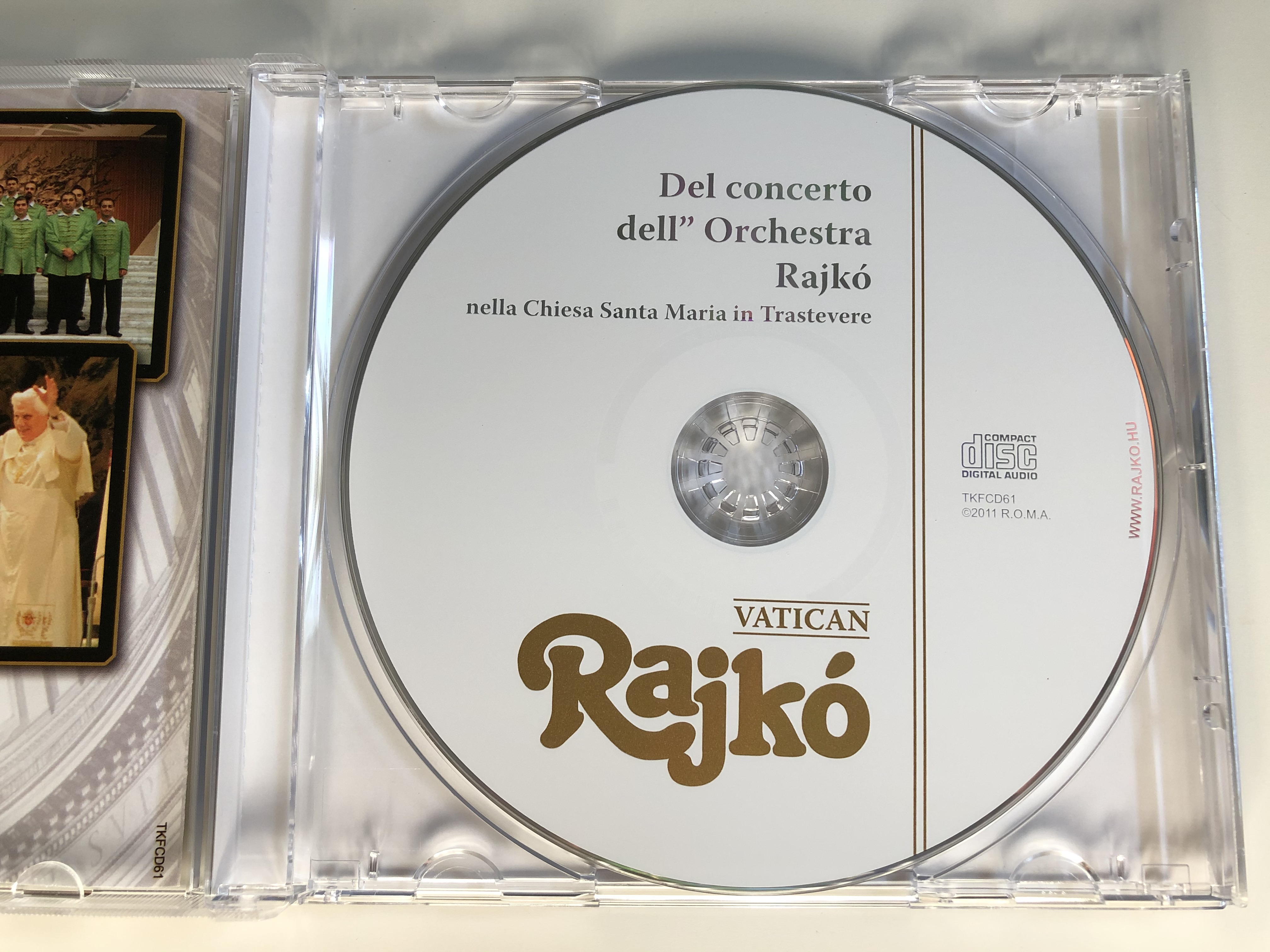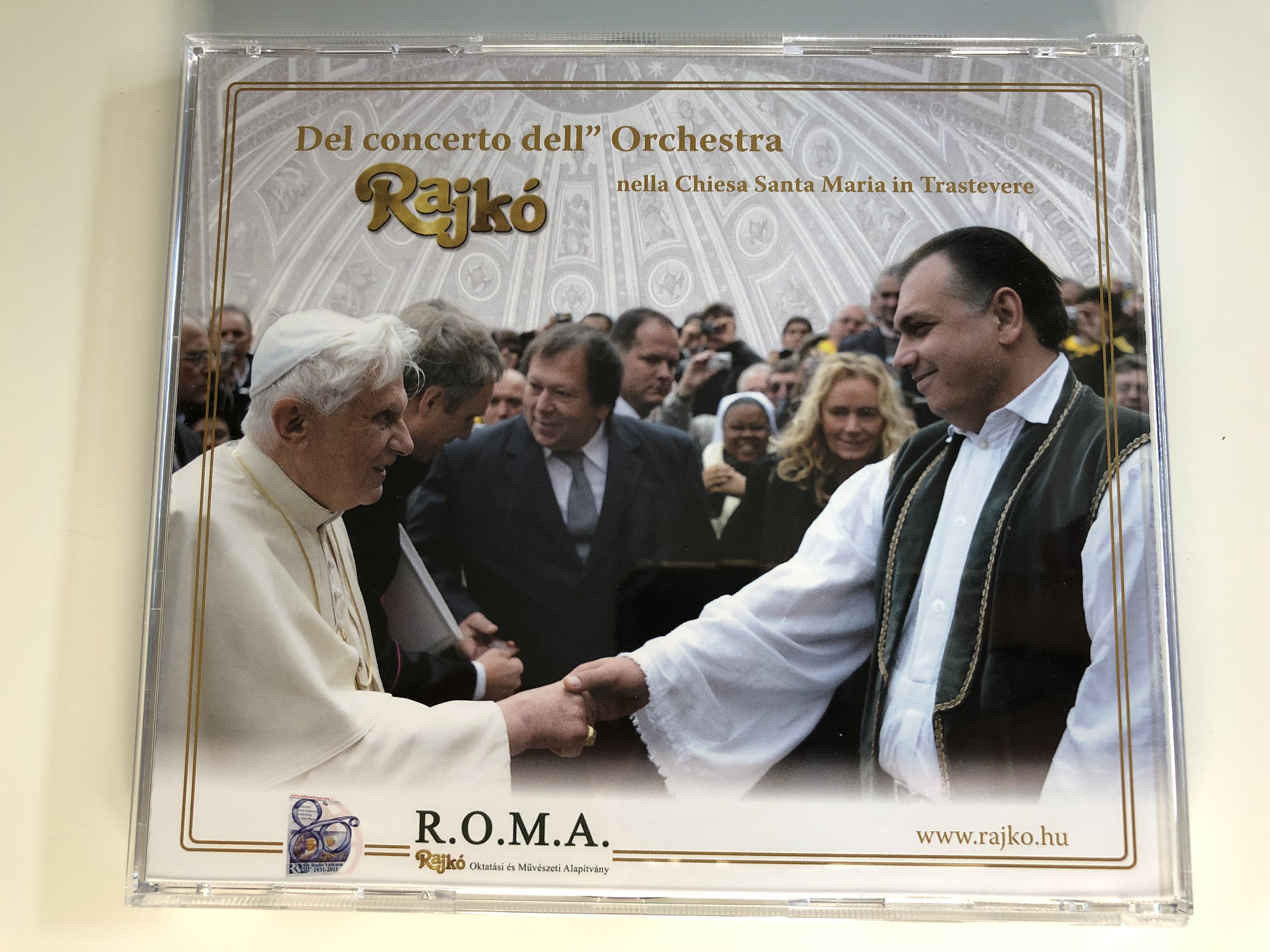Description
Vatican - Rajko Zenekar / R.O.M.A. Audio CD 2011 / Del concerto dell'' Orchestra Rajko nella Chiesa Santa Maria Trestevere
TKFCD61
The Basilica of Santa Maria in Trastevere (Italian: Basilica di Santa Maria in Trastevere); English: Our Lady in Trastevere) is a titular minor basilica in the Trastevere district of Rome, and one of the oldest churches of Rome. The basic floor plan and wall structure of the church date back to the 340s, and much of the structure to 1140-43. The first sanctuary was built in 221 and 227 by Pope Callixtus I and later completed by Pope Julius I. The church has large areas of important mosaics from the late 13th century by Pietro Cavallini.
- Label: R.O.M.A. - TKFCD61
- Format: CD, Album
- Country: Hungary
- Released: 2011
- LC: .99
Tracklist:
1. Brahms: Danza Ungherese n.5.
2. Liszt: Rapsodia Ungherese n.2.
3. Massanet: Thais Meditazione
4. Bartok: Danze Rumene
5. Mozart: Eine kleine nachtmusic
6. Gyula Farkas: Fantasia tzigana
7. Bach-Gounod: Ave Maria
8. Bach: Concerto di violino doppio
9. Vecsey: Valse Triste
10. Canto Maria n. 236
11. Kodaly: Doppio di Kalla
12. Remenyi: Vola, mio rondine
FROM: http://rajko.hu/en/rajko-orchestra-is-65/
Rajko Orchestra was founded in 1952 by Pál Szigeti, director and Gyula Farkas art director, conductor. Their aim was to create the opportunity for young gifted Roma children from different parts of Hungary to be able to preserve and improve the traditions of gypsy music.
The main objective of their work was to transmit gypsy music from pubs’ scenes to the great stages of the world.
In the past 65 years thousands of young musicians have been educated in Rajko Orchestra, who represent values that are only represented by the Rajkos in Hungary. Several CDs, DVDs, videos and cassettes retain that huge music repertoire that is characteristic of the orchestra.
In that repertoire we can find classical music, folk music, gypsy music and operetta. We play music by Zoltán Kodály, Béla Bartók or Ferenc Liszt.
The orchestra’s unique talent is proved by special performances like the “Klezmer-symphony”, played together with the Budapest Klezmer Band, or the “Romantiada” production presented with Iván Markó ballet artist and the Festival Ballet in the Hungarian National Theatre.
Our show called “Ancient Pulse” that lumps masterpieces of Irish and Hungarian folk dance together, and that we have composed together with Ronan Morgan choreographer, who used to be a soloist in Michael Flatley’s group.
We have had several concerts together with the Dohnányi Orchestra Budafok directed by Gábor Hollerung.
We have had a performance with János Balázs, a pianist with Franz Liszt prize.
The Duna Art Ensemble and Rajko Orchestra have presented “Kállai kettős” at MÜPA (Palace of Arts).
Rajko Orchestra has presented almost 10,000 performances in 116 countries, on all continents of the world, we have even played in the Vatican in these 65 years.
Our orchestra’s music fascinated those more than 10 million listeners, who have been curious to listen to the values and traditions of Hungarian gypsy music played at wide variety of places...
HUNGARIAN INFO:
A Rajkó Zenekar 1952-ben Szigeti Pál igazgató és Farkas Gyula művészeti vezető, karmester vezetésével jött létre. Fő céljuk az volt, hogy a magyarországi cigányzene meghódítsa a világ nagy színpadjait, bebizonyítsak, hogy a cigányzene sokkal több annál, hogy éttermekben, kocsmákban szórakoztassa az embereket. Farkas Gyula több, a magyar cigányzene ihletésére írt klasszikus művet hangszerelt vissza cigányzenekarra, így pl. Liszt Ferenc, Monti, Sarasate, Brahms, Bartók és Kodály műveit.
Farkas Gyula nevéhez fűződik szintén a „rajkó iskola” létrehozása, melynek fő tevékenysége a cigány származású fiatal tehetségek felkutatása és taníttatása volt az ötvenes évek elején. Szigeti Pálnak köszönhető az, hogy szerte a világon megismerték a Rajkó nevet, valamint ő volt az is, aki megálmodta és kialakította a zenekar és a tánckar imázsát. Farkas Gyula munkáját Mészáros Tivadar folytatta, a zenekar jelenlegi művészeti vezetője Suki András, aki maga is Farkas Gyula tanítványa volt. Eddig több ezer tehetséges fiatal került ki a Rajkó-iskolából.
A Rajkó Zenekar a világ összes földrészén, 110 országban lépett fel. A művészegyüttes produkciói nem mindennaposak, hanem újszerűek és korszerűek, ezért a világ minden táján örömmel fogadják őket. Mára a zenekar visszajáró vendég lett számos nagy európai városba, valamint Amerikában és Ázsiában is. A zenekar zenei világa igen színes és változatos, a műsor típusától függően megjelenik benne a cigányzene, a népzene, az operett és a klasszikus zeneirodalom legsikeresebb művei is. Számos CD, DVD és kazetta jelent meg a Rajkó Zenekar különböző produkcióiról. Jellemzőjük, hogy változatos formációkkal lépnek fel a világ színpadaira, hol koncertező nagyzenekarként, hol 6-8 személyes kamaraegyüttesként vagy ének- és tánckísérő zenekarként. E színességnek köszönheti a zenekar, hogy a világ összes kontinensén fellépett már és számos fővárosban aratott nagy sikert.
A Rajkó Tánckar 1950-ben alakult, amely 1973 óta hivatásos tánckarként működik. A Rajkó Zenekar folklór és operett műsorait színesíti. Kiváló koreográfusok alkották meg a koreográfiákat: Somogyi Tibor, Szirmai Béla. Mára a tánckar kibővült és a neves koreográfusoknak köszönhetően világszínvonalú műsorokkal állnak ki a közönség elé. A társulat a világ 34 országában lépett már fel és több mint 60 000 fellépésen van túl. Legtöbbször a Rajkó Zenekar folklór műsorát színesíti ma is, de szívesen fellépnek kamaraprodukciókkal nemzetközi estélyeken, rendezvényeken is. A Tánckar vezetője ma Horváth István, művészeti vezetője Berzsenyi László.





































